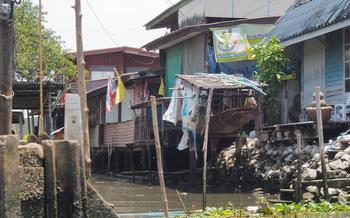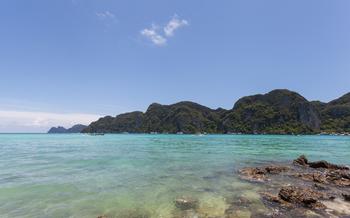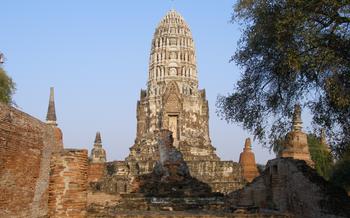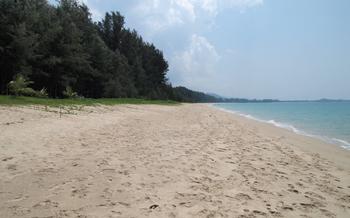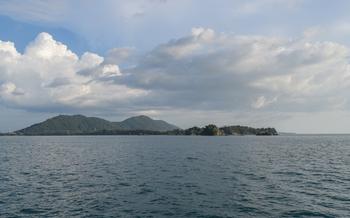
Kapoe Mangrove Forest
- About Kapoe Mangrove Forest
- Exploring the Forest
- Flora and Fauna
- Activities and Experiences
- Best Time to Visit
- Visitor Facilities
- Photography Opportunities
- Accommodations Nearby
- Food and Beverages
- Cultural Experiences
- Historical Significance
- Community Involvement
- Insider Tip:
About Kapoe Mangrove Forest
Nestled along the pristine coastline of Ranong, Thailand, lies the enchanting Kapoe Mangrove Forest, a natural wonder that has captured the hearts of nature enthusiasts and adventurers alike. This remarkable forest holds a rich history and ecological significance, serving as a sanctuary for diverse flora and fauna.
Established as a protected area in 1984, Kapoe Mangrove Forest encompasses over 43 square kilometers of breathtaking landscapes, including intricate mangrove channels, lush green canopies, and teeming wildlife. Its unique location at the convergence of the Andaman Sea and the Kraburi River has created a diverse ecosystem that sets it apart from other mangrove forests in the region.
Conservation efforts have been diligently implemented to preserve the delicate balance of this vital ecosystem. The establishment of the Kapoe Mangrove Forest Conservation Center spearheads initiatives to protect and restore the forest's mangrove habitats, raise awareness about its ecological significance, and promote sustainable tourism practices.
Exploring the Forest
There are several ways to explore the Kapoe Mangrove Forest, each offering a unique perspective and experience.
Guided Tours: Join a guided tour led by experienced naturalists or local guides who can provide insights into the forest's ecosystem, flora, and fauna. These tours often include boat rides through the mangrove channels, allowing you to observe wildlife up close.
Self-Guided Walks: For a more independent experience, opt for a self-guided walk along the elevated boardwalk that winds through the forest. Take your time to admire the diverse mangrove species, spot wildlife, and capture stunning photographs.
Kayaking: Glide through the narrow mangrove channels in a kayak, offering a unique perspective of the forest from the water level. Kayaking allows you to explore hidden corners and encounter wildlife that may not be visible from the boardwalk.
Flora and Fauna
The Kapoe Mangrove Forest is home to a diverse array of mangrove species, each adapted to the unique conditions of this coastal ecosystem. Among the most common species are the Red Mangrove (Rhizophora apiculata), with its distinctive prop roots that help anchor it in the soft mud, and the Black Mangrove (Bruguiera gymnorhiza), known for its dark green leaves and tolerance to high salinity. These mangroves play a crucial role in stabilizing the shoreline, preventing erosion, and providing a habitat for a variety of wildlife.
The forest is also a haven for a wide range of animals, including monkeys, birds, and mudskippers. Long-tailed macaques, with their playful and inquisitive nature, are a common sight in the forest, often seen swinging through the trees or foraging for food. Bird enthusiasts will delight in the vibrant calls and colorful plumage of the many bird species that inhabit the forest, including herons, egrets, and kingfishers. Mudskippers, with their unique ability to breathe air and skip across the mudflats, add a touch of whimsy to the forest ecosystem.
The mangrove ecosystem is of immense importance for biodiversity conservation. Mangroves provide critical breeding and nursery grounds for many marine species, including fish, crabs, and shrimp. The complex root systems of mangroves act as a filter, trapping sediments and pollutants, helping to maintain the water quality and supporting a diverse array of marine life. By conserving the Kapoe Mangrove Forest, we not only protect the unique flora and fauna that call it home but also contribute to the overall health and resilience of the marine ecosystem.
Activities and Experiences
The Kapoe Mangrove Forest offers a diverse range of activities and experiences that cater to nature enthusiasts, adventure seekers, and those seeking a tranquil escape. One of the most popular activities is birdwatching, as the forest is home to a rich variety of bird species. Visitors can spot colorful kingfishers, majestic brahminy kites, and the elusive Oriental darter, among many others.
Photography enthusiasts will delight in capturing the stunning beauty of the forest's landscapes, intricate root systems, and abundant wildlife. The elevated boardwalk and observation towers provide excellent vantage points for panoramic shots, while close-up photography reveals the intricate details of the mangrove ecosystem. However, it's important to remember to respect wildlife and avoid disturbing their natural behavior while taking photos.
For those seeking a more active experience, kayaking through the mangrove channels is a must-do. Glide along the tranquil waters, surrounded by the lush greenery and the sounds of nature. Kayaking offers a unique perspective of the forest, allowing visitors to explore hidden corners and observe wildlife from a different angle.
Additionally, visitors can immerse themselves in the local culture by visiting nearby fishing villages. Learn about traditional fishing techniques, witness the daily life of the villagers, and sample the freshly caught seafood. These interactions provide a glimpse into the unique way of life that has thrived in harmony with the mangrove ecosystem for generations.
Best Time to Visit
The best time to visit Kapoe Mangrove Forest is during the dry season, which runs from November to April. During this time, the weather is generally pleasant, with warm and sunny days and cool nights. The forest is also less crowded during this period, allowing you to enjoy a more peaceful and immersive experience.
While the dry season is ideal for exploring the forest, it's important to note that some activities, such as kayaking, may be restricted during this time due to lower water levels. If kayaking is a priority, consider visiting during the wet season (May to October) when the water levels are higher. However, be prepared for occasional rainfall and the possibility of muddy trails.
To avoid crowds and ensure a more tranquil visit, plan your trip during weekdays rather than weekends or public holidays. Early mornings and late afternoons are also quieter times to explore the forest, as most tour groups tend to visit during the midday.
Visitor Facilities
The Kapoe Mangrove Forest offers a range of visitor facilities to enhance the experience for travelers. Well-maintained restrooms are available at strategic locations within the forest, ensuring convenience for visitors. Designated picnic areas provide a pleasant spot to take a break, enjoy packed lunches, and soak in the natural surroundings. For those seeking souvenirs to remember their visit, a gift shop offers a selection of locally crafted items, including handmade crafts, mangrove-themed souvenirs, and local delicacies.
Additionally, the forest is accessible to visitors with disabilities or special needs. Designated pathways with ramps and handrails allow wheelchair users to navigate the forest comfortably. The Kapoe Mangrove Forest embraces responsible tourism practices, encouraging visitors to dispose of waste properly in designated bins to minimize environmental impact. Respecting wildlife and refraining from disturbing their natural behavior is essential for preserving the delicate ecosystem. By following these guidelines, visitors can contribute to the sustainable conservation of this unique natural wonder.
Photography Opportunities
The Kapoe Mangrove Forest presents a photographer's paradise, with a myriad of captivating scenes waiting to be captured. From panoramic vistas atop observation towers to close-up encounters with intricate mangrove roots and diverse wildlife, every frame promises a unique masterpiece. To fully harness the forest's photographic potential, consider the following tips:
-
Lighting: Plan your visit to coincide with the golden hours of sunrise or sunset when the soft, warm light casts an ethereal glow upon the mangroves, creating a magical ambiance.
-
Composition: Experiment with different angles and perspectives to create dynamic shots. Capture the vastness of the forest from an elevated vantage point, or get down low to showcase the intricate details of the mangrove roots and their reflection in the water.
-
Wildlife: Photographing wildlife requires patience and stealth. Use a telephoto lens to capture candid moments of monkeys swinging through the trees, birds taking flight, or mudskippers hopping across the mudflats.
-
Respect Wildlife: Remember that these creatures are wild and must be respected. Maintain a safe distance, avoid using flash photography, and never attempt to touch or disturb the animals.
Accommodations Nearby
When planning your trip to Kapoe Mangrove Forest, you'll find a range of accommodation options nearby to suit different budgets and preferences. For a budget-friendly stay, consider guesthouses or hostels, which offer basic amenities at affordable rates. Mid-range hotels provide more comfort and convenience, often with air-conditioned rooms and private bathrooms. If you seek a luxurious experience, opt for one of the upscale resorts in the area, which offer stunning views, private balconies, and a host of amenities.
For those who prefer to immerse themselves in nature, there are charming bungalows and treehouses available within or near the forest. These accommodations offer a unique opportunity to wake up to the sounds of the jungle and enjoy the tranquility of the forest right at your doorstep.
To ensure a hassle-free stay, book your accommodation in advance, especially if you're visiting during peak tourist season. Research online or consult with local travel agents to find the best deals and availability.
Food and Beverages
When visiting Kapoe Mangrove Forest, don't miss the opportunity to indulge in the local cuisine and delicacies. Ranong is known for its fresh seafood, caught daily by local fishermen. Try dishes like "Gaeng Som Pla Kapong" (Southern-style fish curry) or "Tom Yum Goong" (spicy shrimp soup) for a taste of authentic Thai flavors. Tropical fruits are abundant in the region, so be sure to sample exotic fruits like mangosteen, rambutan, and durian. For a sweet treat, try "Khanom Chin" (sweet sticky rice noodles in coconut milk) or "Lod Chong" (green rice noodles in sweet coconut milk). You can find these local delicacies in nearby restaurants or markets. Pack a lunch or snacks to bring along on your forest explorations, as food options within the forest are limited.
Cultural Experiences
Immerse yourself in the vibrant culture of Ranong province by exploring the communities that call the Kapoe Mangrove Forest their home. Visit nearby fishing villages to witness the traditional practices of local fishermen, using techniques passed down through generations. Learn about their way of life, their struggles, and their triumphs as they navigate the ever-changing tides of the sea.
Attend local festivals or events that showcase Ranong's unique cultural heritage, such as the Ranong Mangrove Festival, where you can experience traditional performances, savor delicious local cuisine, and participate in cultural workshops. These festivals offer a glimpse into the rich tapestry of traditions that make Ranong so special.
Engage with the friendly locals, who are always eager to share their stories and insights about the forest and their community. Learn about their beliefs, their customs, and their deep connection to the land and sea. Through these interactions, you'll gain a deeper understanding of the cultural fabric that weaves together the tapestry of Ranong province.
Historical Significance
The Kapoe Mangrove Forest holds significant historical value within the Ranong province. Legends and stories passed down through generations speak of its role as a vital resource for local communities. In the past, the forest provided shelter and sustenance to seafaring traders and fishermen who sought refuge along its shores. It is believed that the forest's name, "Kapoe," originated from the Thai word "kapook," which means cotton, due to the abundance of kapok trees found within its depths. These trees were highly valued for their fibers, which were used to make pillows, mattresses, and other household items. The Kapoe Mangrove Forest has remained a symbol of resilience and a reminder of the deep connection between the local people and their natural environment.
Community Involvement
The Kapoe Mangrove Forest is not just a natural wonder; it is also a source of livelihood and cultural identity for the local communities. Several initiatives are in place to involve these communities in forest conservation and sustainable tourism. Visitors can contribute to these efforts by supporting local businesses, such as homestays, restaurants, and souvenir shops. This not only helps to boost the local economy but also encourages the community to take an active role in protecting the forest.
Furthermore, visitors can volunteer their time to participate in conservation activities, such as tree planting, mangrove restoration projects, and wildlife monitoring. These opportunities provide a unique chance to learn about the forest's ecosystem and contribute directly to its preservation.
When interacting with the local community, it is essential to be respectful of their customs and traditions. Visitors should dress appropriately, avoid using offensive language or gestures, and always ask permission before taking photographs. By showing respect and understanding, visitors can help to build a positive relationship between tourists and the local community, ensuring that the forest remains a cherished part of Ranong's heritage for generations to come.
Insider Tip:
Venture beyond the main tourist trails and discover the hidden gems of Kapoe Mangrove Forest. Ask your guide or a local resident about the secret spots they frequent, such as secluded mangrove channels, serene viewpoints, or hidden wildlife habitats. These lesser-known areas offer a more intimate and authentic experience, allowing you to connect with the forest's tranquility and diverse wildlife. Embrace the opportunity to explore off the beaten path and create unique memories that will set your journey apart.

